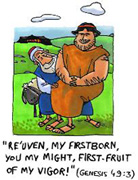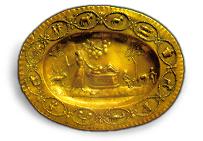|

 
Biblical
legislation gave the firstborn male a special status with respect to
certain cultic regulations and inheritance rights. Along with the first
fruits of the soil and the first male offspring of herd and flock, the
firstborn son was considered sacred, the exclusive possession of God.
If in the popular consciousness, the first issue of herds, flocks, and
first fruits were considered particularly desirable as sacrifices or
offerings, it was natural that where human sacrifice was practiced,
the firstborn was considered the most desirable sacrifice to its deity;
for example, the king of Moav, on the verge of defeat, sacrifices his
eldest son.[1]
In Biblical Hebrew usage, the firstborn male of human beings and animals
is usually called bekhor, and less frequently peter rehem.
The animal "firstborn" is always that of the mother, while for human
beings, bekhor can be either of the mother or the father. In
most instances, however, the firstborn is of the father. (See Lowin's
article on the Hebrew root-word b-kh-r.)
 According
to Deuteronomy[2],
a father was obliged to acknowledge his firstborn son as his principal
heir, and to grant him a double portion of his estate as inheritance,
i.e., a double portion of his fraction of the inheritance depending
on the number of sons. It is evident from the composition of biblical
genealogies that the status of bekhor was a pervasive feature
of Israelite life. Nonetheless, we see primogeniture disregarded in
the transmission of the early Hebrew clan's unique religious belief;
Abraham, Isaac and Jacob all pass by (and sometimes banish) the firstborn
in favor of the son deemed more suited to carry on the clan line and
belief (see Nahum Sarna's article on this
subject). According
to Deuteronomy[2],
a father was obliged to acknowledge his firstborn son as his principal
heir, and to grant him a double portion of his estate as inheritance,
i.e., a double portion of his fraction of the inheritance depending
on the number of sons. It is evident from the composition of biblical
genealogies that the status of bekhor was a pervasive feature
of Israelite life. Nonetheless, we see primogeniture disregarded in
the transmission of the early Hebrew clan's unique religious belief;
Abraham, Isaac and Jacob all pass by (and sometimes banish) the firstborn
in favor of the son deemed more suited to carry on the clan line and
belief (see Nahum Sarna's article on this
subject).
Following the dramatic story of the tenth plague inflicted upon firstborn
Egyptian males, God acquires title to the firstborn of man and beast
in Israel, for having spared them in this plague. According to the priestly
tradition, the Levites were devoted to cultic service in substitution
for all the firstborn Israelites[3].
The laws governing the redemption of the firstborn from this cultic
service[4]
suggest that at one time firstborn sons were actually devoted to cultic
service as temple slaves; subsequently, other arrangements were made
for supplying "cultic personnel" (i.e., the Levites).
The firstborn could thus be relieved of their sacral status and cultic
destiny through redemption. Rabbinic sources discuss at length methods
of exchange and redemption, which take place in a ceremony known as
pidyon ha-ben (lit. "redemption of the firstborn"), in the presence
of a kohen (descendant of the priestly family) and other guests.

From
the collection of the Sir Isaac and Lady Edith Wolfson Museum
(Hechal Shlomo, Jerusalem)
This
brass plate was used for the pidyon ha-Ben ceremony. Many plates
of this type were made by silversmith Dornhelm of Lvov in the early
19th century for decorative purposes, and were then used to carry the
infant during the pidyon ha-Ben ceremony. While the subject of
the central panel varies, they are all in the folk style popular among
18th to early-19th century East European Jews. This oval plate is decorated
with the zodiac signs and a depiction of the Binding of Isaac in high
relief at its center.
:
|